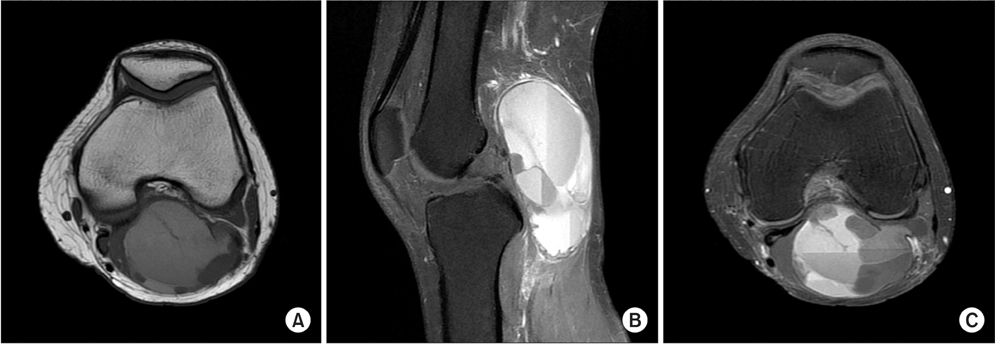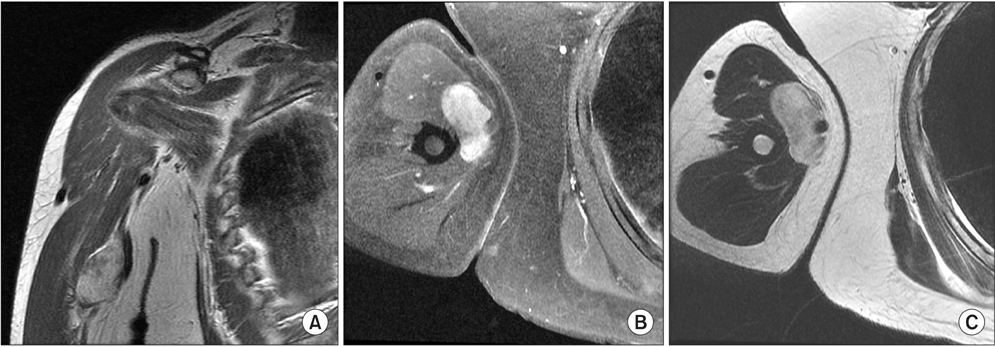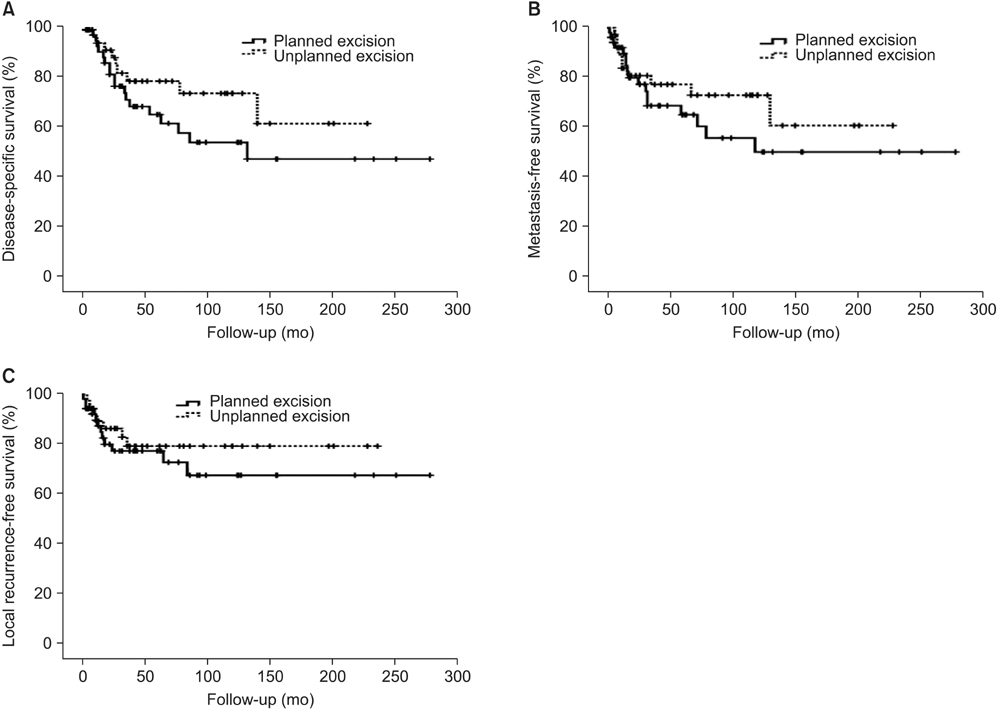Clin Orthop Surg.
2015 Jun;7(2):254-260. 10.4055/cios.2015.7.2.254.
Distinct Clinical Characteristics of Unplanned Excision in Synovial Sarcoma
- Affiliations
-
- 1Department of Orthopedic Surgery, Seoul National University Hospital, Seoul National University College of Medicine, Seoul, Korea. hankim@snu.ac.kr
- 2Department of Orthopaedic Surgery, Gachon University Gil Hospital, Incheon, Korea.
- 3Orthopaedic Oncology Service, National Cancer Center, Goyang, Korea.
- KMID: 2164553
- DOI: http://doi.org/10.4055/cios.2015.7.2.254
Abstract
- BACKGROUND
We aimed to describe the clinical characteristics and outcomes of unplanned excisions of synovial sarcomas.
METHODS
In total, 90 patients with synovial sarcomas in the extremities were retrospectively reviewed. Patients were divided into unplanned excision (n = 38) and planned excision (n = 52) groups. The average follow-up period was 6 years. The clinicopathological characteristics and oncologic outcomes were compared.
RESULTS
The unplanned excision group showed longer duration of symptoms before diagnosis (p = 0.023), smaller lesion dimensions (p = 0.001), superficial location (p = 0.049), and predilection in the upper extremities (p = 0.037). Synovial sarcomas were most commonly misdiagnosed as neurogenic tumors (56%) in the upper extremities or as cystic masses (47%) in the lower extremities. Oncological outcomes, including disease-specific survival, metastasis-free survival, or local recurrence were not significantly different between the 2 groups (p = 0.159, p = 0.444, and p = 0.335, respectively). Repeated unplanned excision (p = 0.012) and delayed re-excision (p = 0.038) were significant risk factors for local recurrence in the unplanned excision group.
CONCLUSIONS
Synovial sarcomas treated with unplanned excision had distinct characteristics. These findings are important for developing diagnostic and therapeutic strategies for synovial sarcoma.
MeSH Terms
Figure
Cited by 1 articles
-
Synovial Sarcoma Complicating Total Knee Arthroplasty
Olga D. Savvidou, George D. Chloros, Panagiotis Koutsouradis, Panayiotis D. Megaloikonomos, Eva Skarpidi, Panayiotis J. Papagelopoulos
Clin Orthop Surg. 2017;9(4):547-552. doi: 10.4055/cios.2017.9.4.547.
Reference
-
1. Fisher C. Synovial sarcoma. Ann Diagn Pathol. 1998; 2(6):401–421.2. Chandrasekar CR, Wafa H, Grimer RJ, Carter SR, Tillman RM, Abudu A. The effect of an unplanned excision of a soft-tissue sarcoma on prognosis. J Bone Joint Surg Br. 2008; 90(2):203–208.3. Trovik CS. Scanadinavian Sarcoma Group Project. Local recurrence of soft tissue sarcoma: a Scandinavian Sarcoma Group Project. Acta Orthop Scand Suppl. 2001; 72(300):1–31.4. Han I, Kang HG, Kang SC, Choi JR, Kim HS. Does delayed reexcision affect outcome after unplanned excision for soft tissue sarcoma? Clin Orthop Relat Res. 2011; 469(3):877–883.5. Qureshi YA, Huddy JR, Miller JD, Strauss DC, Thomas JM, Hayes AJ. Unplanned excision of soft tissue sarcoma results in increased rates of local recurrence despite full further oncological treatment. Ann Surg Oncol. 2012; 19(3):871–877.6. Zagars GK, Ballo MT, Pisters PW, Pollock RE, Patel SR, Benjamin RS. Surgical margins and reresection in the management of patients with soft tissue sarcoma using conservative surgery and radiation therapy. Cancer. 2003; 97(10):2544–2553.7. Chotel F, Unnithan A, Chandrasekar CR, Parot R, Jeys L, Grimer RJ. Variability in the presentation of synovial sarcoma in children: a plea for greater awareness. J Bone Joint Surg Br. 2008; 90(8):1090–1096.8. Valenzuela RF, Kim EE, Seo JG, Patel S, Yasko AW. A revisit of MRI analysis for synovial sarcoma. Clin Imaging. 2000; 24(4):231–235.9. Blacksin MF, Siegel JR, Benevenia J, Aisner SC. Synovial sarcoma: frequency of nonaggressive MR characteristics. J Comput Assist Tomogr. 1997; 21(5):785–789.10. Guillou L, Benhattar J, Bonichon F, et al. Histologic grade, but not SYT-SSX fusion type, is an important prognostic factor in patients with synovial sarcoma: a multicenter, retrospective analysis. J Clin Oncol. 2004; 22(20):4040–4050.11. Greene FL. American Joint Committee on Cancer. American Cancer Society. AJCC cancer staging manual. 6th ed. New York: Springer;2002.12. Krieg AH, Hefti F, Speth BM, et al. Synovial sarcomas usually metastasize after >5 years: a multicenter retrospective analysis with minimum follow-up of 10 years for survivors. Ann Oncol. 2011; 22(2):458–467.13. Berquist TH, Ehman RL, King BF, Hodgman CG, Ilstrup DM. Value of MR imaging in differentiating benign from malignant soft-tissue masses: study of 95 lesions. AJR Am J Roentgenol. 1990; 155(6):1251–1255.14. Stacy GS, Nair L. Magnetic resonance imaging features of extremity sarcomas of uncertain differentiation. Clin Radiol. 2007; 62(10):950–958.15. Fiore M, Casali PG, Miceli R, et al. Prognostic effect of re-excision in adult soft tissue sarcoma of the extremity. Ann Surg Oncol. 2006; 13(1):110–117.16. Spurrell EL, Fisher C, Thomas JM, Judson IR. Prognostic factors in advanced synovial sarcoma: an analysis of 104 patients treated at the Royal Marsden Hospital. Ann Oncol. 2005; 16(3):437–444.17. Deshmukh R, Mankin HJ, Singer S. Synovial sarcoma: the importance of size and location for survival. Clin Orthop Relat Res. 2004; (419):155–161.
- Full Text Links
- Actions
-
Cited
- CITED
-
- Close
- Share
- Similar articles
-
- Results of Re-Excision Following Unplanned Excision of Soft Tissue Sarcoma: Comparison with the Group of Planned Excision
- Congenital Synovial Sarcoma in Ankle: Report of A Case
- A Case of Transoral Endoscopic Excision of Recurred Synovial Sarcoma in Pyriform Sinus
- Synovial Sarcoma of the Thumb: A Case Report
- A Case Report of Synovial Sarcoma




